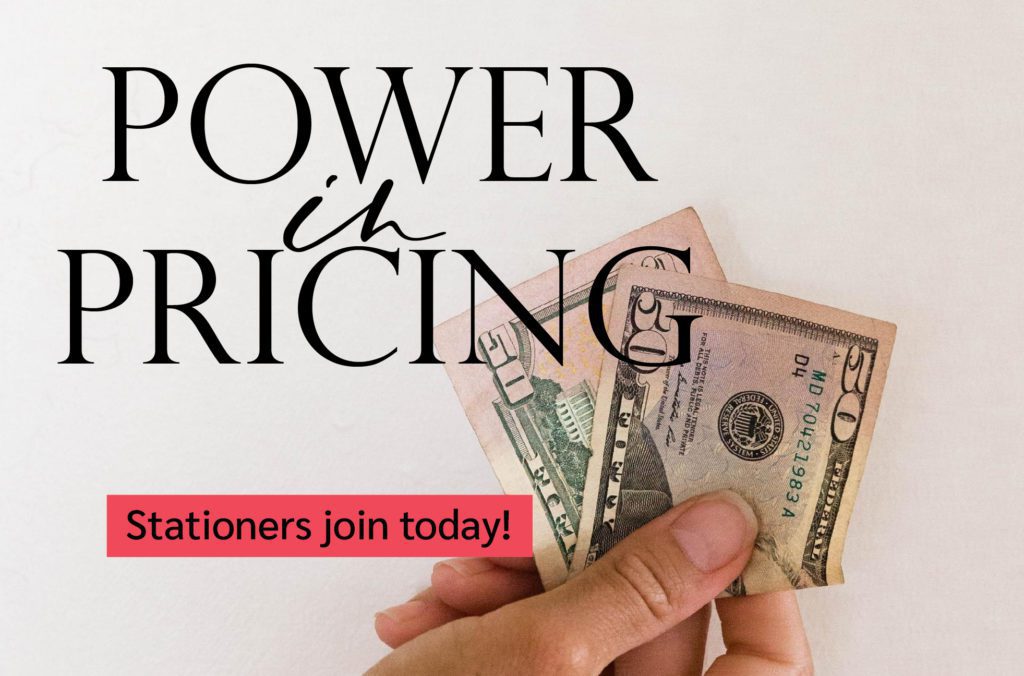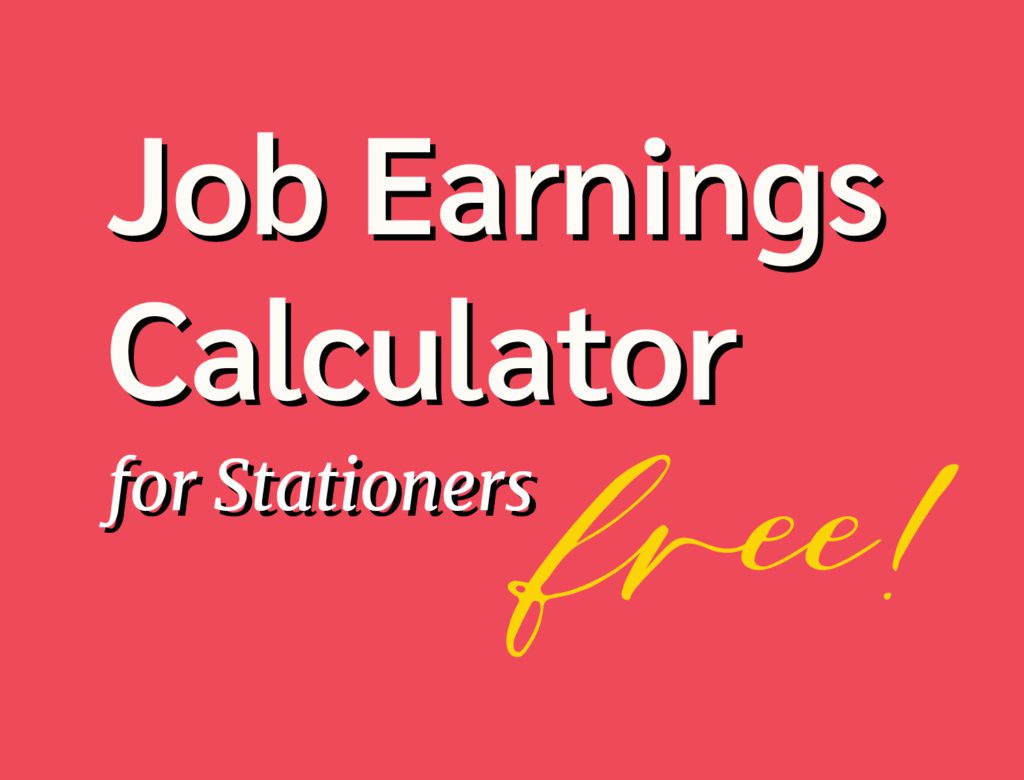Affilate Marketing
All Things Printing
Business Resources
CRMs and Systems
Marketing
Tips & Tricks
Hi, I'm Laney!
I make wedding invitations and I teach artists how to work smarter, make money, and run a business that works for you.
We'd love to have you join us - signup for our email list to get DBL updates, stationery design tricks, business tips and more!
What numbers are normal for a stationery business profit margin? How can you increase your profit margins? What’s even the point of a profit margin? These are the questions I’ll discuss today!
First, check out this video on how to start a stationery business!
These tips will apply no matter what stationery business you want to start, but for profit margins I’ll mostly be talking about wedding stationery, as that’s my area of expertise.
Before we get started, here’s a free downloadable Job Earnings Calculator! It’ll help you figure out what you’ve earned on jobs in the past (a lot of people who fill this out say it works out to be way less than they expected!). Test it out and see how your current pricing is doing!
What is a Profit Margin?
Before we dive into what your stationery business profit margins should be, we need to cover what a profit margin is. You’ve probably heard about margins on Shark Tank or something, so you’re thinking of it in the context of “what should I charge for something that costs me $1 to produce?”.
In truth, margins go much deeper than that.
Figuring out what percentage of your sale is profit is a calculation of “Gross Profit Margin”. Literally how much of your sale is not direct cost. If you sell something for $3 and it costs you $1 then gross profit is $2 and margin is ⅔ or 66.7%.
Are Gross Profit Margins a good Indicator?
Yes and no. Of course, you want a good profit margin on your individual products, but that gross profit margin doesn’t tell the full story of your stationery business. It doesn’t account for overhead, taxes, internet, training and education, etc. Any supplies that weren’t bought specifically for this job aren’t included – but you’re likely using lots of other invitation supplies, graphic design software, and other stationery tools on every project.
What’s typically viewed as a better indicator of the health of your business is net profit margin – which is all of your expenses subtracted from all of your profits. Typically a number around 10% is considered fairly healthy, but it will depend on your business a lot.
Only 10%?
Yep, that’s true. It seems like a small number, but that doesn’t mean that you need to charge $1.10 for a product that costs you $1.
This net profit margin takes everything into account, not just the cost of the product that you’re selling. So how much should your profit margin be on a single job?
That’s up to you – but a common markup range that’s used is about 2.5-3x. So if something costs you $1, you generally should try to charge $2.50 – $3 for that.
Why do I have to have Profit Margins?
Wouldn’t it be nice if we could sell our stationery for only $0.10 more than it cost us to make? It’s still an extra $0.10, right? That’s a profit, isn’t it?
Well, not really. If you work for someone else’s company and they pay you hourly, and all the sudden you get $.10 more per hour – that’s a raise. It’s $0.10 extra that you get to take home every hour, no matter what.
But if you work for yourself, you don’t do billable work 8 hours a day. If you want to paint all day, charge $100/hour and make $800/day, then you need to work as a painter for someone else’s company.
As a small business owner, your billable work has to account for keeping your business afloat (and thriving!). That includes paying your bills, answering emails, marketing, any education you need to stay relevant, the cost of sample designs and prints, your insurance, and a thousand other costs associated with running a business.
That’s what profit margins cover. So a good place to start is if you work on billable work about 1/2 the time (4 hours/day) then you should double your hourly rates or product costs to cover that extra time doing admin work. It’s not a perfect calculation, but it’s a starting point.
Do you need a Good Stationery Profit Margin?
This section is for those of you in the custom invitation world. If you do wholesale stationery, semi-custom stationery, anything that’s more transactional – then yes, you need to pay a lot of attention to that margin. See some tips below for increasing your stationery business profit margin!
If you work in a more customized way, then you may not need super high margins. You just need to pay attention to the profit amount.
What’s the difference? Instead of caring about the percentage of your revenue that’s profit, you can pay attention to the dollar amount. As long as that is where you want/need it to be, it doesn’t matter so much where your profit margin falls.
Here’s an example:
Stationery designer A (let’s call her Alice!) makes $150,000 in revenue every year. Her expenses are $100,000. Her profit margin is 33%, and she profits $50,000.
Stationery designer B (let’s call her Betty!) makes $100,000. Her expenses are $50,000. Her profit margin is 50% and she takes home $50,000.
It might feel like Betty has a better business. But in real life, she’s taking home the same amount as Alice. Does it really matter about the percentage at this point? Maybe, that’s up to you to decide.
I’m not going to tell you what your profit margins HAVE to be. But to be successful in this business, you definitely need to take into account more costs and overhead than just your cost of paper and printing materials.
And if you’re looking for investors, or to scale your business quickly on the wholesale side, then you likely want to pay more attention to your margins than just the profit amount. Those are a better sign of potential growth, and investors will want to know those numbers.
Here are 2 pricing strategies for Invitation Design Businesses!
How do you Increase your Stationery Business Profit Margin?
Increasing your profit margins no matter what type of business you have can be done in one of two ways:
- Increase your sales while keeping expenses the same.
- Decrease your expenses while keeping sales the same.
When it comes to stationery, there are honestly countless ways to increase your sales. There are some marketing tips in the video at the beginning of this post, and on my YouTube channel (here’s the Marketing Playlist)!
If you want to increase your stationery sales:
- Sell on Etsy – a built-in marketplace
- Partner with local wedding vendors if you’re a wedding stationer
- Partner with local stores if you’re a wholesale stationer
- Local art/craft shows
- Share your work on Pinterest, Instagram, TikTok, and other social platforms
- Share your work in local Facebook groups
- Learn about SEO (here’s a beginner video!) and build your search traffic
Onto step 2 – Decreasing your expenses! Here are some of my favorite tips:
- Print with wholesale printers – their prices decrease with larger/more orders to save you money
- Get a resale license if your work qualifies for sales and use tax, which will make it so that you’re not paying sales tax on supplies
- Negotiate your utility rates (phone, internet, insurance, design software, etc.)
- Purchase supplies in bulk (if this makes sense for your business)
- Save time by using a Client Management System (here’s some info on my favorite 2 platforms for this).
One thing I want to encourage you not to do is try to do everything yourself in order to save money. I often see new invitation designers assuming that printing in-house will increase their profit margins, because it’s cheap. But you have to make sure you’re taking your time into account, as it’s a limited resource.
If you actually calculate printing costs including time, it’s often more expensive than outsourcing to a professional invitation print vendor. It’s up to you to decide if you want to be a printer, or a designer, or some combination of the two.
In my stationery business, I outsource as much as possible so I can concentrate on design and administrative tasks that I like much more than printing.
Want an in-depth look at how I price my work? Want to price out some stationery projects with me (with real numbers!)? Learn more in Power in Pricing – our one-of-a-kind 4+-hour course for wedding invitation designers.
Some of our students said after taking Power in Pricing:
“My prices doubled, if not more. I’m actually making above minimum wage!”
“I’m able to SEE the profit and understand WHY I’m charging what I am which makes me feel more confident”
“Have much more time in the day, and I don’t feel terrible if someone doesn’t accept a proposal because I didn’t spend half a day creating it.”
“Feeling more confident and changed up my pricing and strategies ASAP”

Stationery Business Profit Margin
Behind the scenes with your favorite Stationery Auntie Laney (and all the inside scoops!)
Not sure where you should start?
I gotchu
Just feeling it out?
Check out our 7 Day Invitation Design Crash Course!
Ready to Start?
Our signature beginner's course From Start to Suite is perfect for you! It's literally *everything* you'll need to get started as a stationer!
Ready to Scale?
Join Stationery School for continuing education with 100+ lessons and new ones released monthly!

[…] Typically a number around 10% is considered fairly healthy, but it will depend on your business a lot. via […]